

Rhinestones, Lead Glass and Crystal Glass
The three terms rhinestone, lead glass and crystal glass are sometimes used in quite a confusing way, in my opinion, so I wanted to know more about them and explain about my findings in a blog.
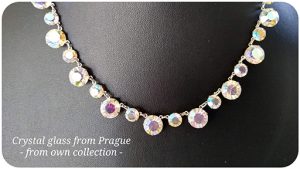 A rhinestone (paste or diamante) is a diamond simulant. Already in the 13th century diamantes or paste were made from Bohemian hand blown glass (situated in current Czech Republic). These were not called rhinestone, though. Originally rhinestones were made from rock crystals, which were found and gathered from the river Rhine and from areas in the Alps. The river Rhine has its source in the south-eastern Swiss Alps (on the border of Liechtenstein and Austria) and flows from the Swiss and Austrian border all the way north through Germany and then west to the Netherlands where it ends in the North Sea. The rock crystals that were found in and near the Rhine could be cut and shaped into pretty imitation diamonds. The little imperfections of the rocks caused them to sparkle like a diamond, which made them very popular for jewellers to use as cheaper alternatives for real diamonds. However, this popularity also caused that soon the natural crystal resources became pretty scarce. Since the nineteenth century rhinestones are also made from crystal glass, gem quartz or polymers, such as acrylic.
A rhinestone (paste or diamante) is a diamond simulant. Already in the 13th century diamantes or paste were made from Bohemian hand blown glass (situated in current Czech Republic). These were not called rhinestone, though. Originally rhinestones were made from rock crystals, which were found and gathered from the river Rhine and from areas in the Alps. The river Rhine has its source in the south-eastern Swiss Alps (on the border of Liechtenstein and Austria) and flows from the Swiss and Austrian border all the way north through Germany and then west to the Netherlands where it ends in the North Sea. The rock crystals that were found in and near the Rhine could be cut and shaped into pretty imitation diamonds. The little imperfections of the rocks caused them to sparkle like a diamond, which made them very popular for jewellers to use as cheaper alternatives for real diamonds. However, this popularity also caused that soon the natural crystal resources became pretty scarce. Since the nineteenth century rhinestones are also made from crystal glass, gem quartz or polymers, such as acrylic.
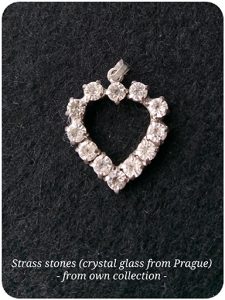 In the second half of the 18th century the Alsatian jeweller Georg Friedrich Strass tried to imitate the effect of diamonds by coating the lower side of lead glass with metal powder. This technique created a result much like the cut and moulded rhinestones from rock crystals or proper diamonds. The diamante that were created this way became very popular as substitutes for both authentic rhinestones and real diamonds and are today often referred to as “strass”.
In the second half of the 18th century the Alsatian jeweller Georg Friedrich Strass tried to imitate the effect of diamonds by coating the lower side of lead glass with metal powder. This technique created a result much like the cut and moulded rhinestones from rock crystals or proper diamonds. The diamante that were created this way became very popular as substitutes for both authentic rhinestones and real diamonds and are today often referred to as “strass”.
At the end of the 19th century, Daniel Swarovski developed and patented a technique and machine for precision cutting and polishing of crystal glass. With his newly invented technique he could mass produce very high quality crystal glass rhinestones, which had a much higher amount of lead content than other glass rhinestones. Because of the higher concentration of lead levels in the glass, the refraction index of the crystals was increased, which enhanced the sparkle of these crystals over conventional glass rhinestones, making them an even better imitation of real diamonds.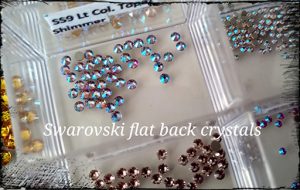
Several companies at the end of the 19th and the beginning of the 20th century, such as Tiffany in 1894, Fenton in 1908 and Swarovski in 1956, started mass producing iridescent lead glass by reducing the metal coating thickness, applying it uniformly and by applying various forms of metal dispositions. Some of these manufacturers, like Swarovski, managed to reproduce the glistening effect of real diamonds, when held in sunlight.
Lead glass is commonly called “crystal”. It is a variety of glass in which lead replaces the calcium content of a typical potash glass. In 1674 the Englishman George Ravencroft discovered a technique to add lead oxide in quantities of 10-30% to glass, which improved the appearance of glass and made it easier to melt it, using sea-coal as furnace fuel. This technique also increased the working time to manipulate the glass in easier ways. Although the term “lead crystal” is not completely accurate to describe lead glass, the use of it remained popular for both historical and commercial reasons. It derives from the Venetian word “cristallo”, which describes the rock crystal that was imitated by the Murano glass makers in Venice.
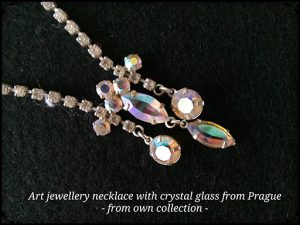 The brilliance of lead crystal relies on a high refractive index caused by the lead oxide, that is added to the molten glass and which gives it a greater sparkle. This happens because the specular reflection of the glass is increased as well as the range of the angles of total internal reflection compared to ordinary glass. In cut glass with facets, both hand-cut or machine-cut, the presence of lead also makes the glass softer and therefore easier to mould. Crystal with a consistency of up to 35% lead (the maximum amount) has the most sparkle. So crystal glass is in fact the same as lead glass, but rhinestones do not per se have to be made from lead glass, but can also be made from polymers, such as acrylic. In fact, crystal rhinestones are predominantly produced by Swarovski in Austria, by Preciosa in the Czech Republic and a few other glass cutters in northern Bohemia. All other produced rhinestones in all other countries are mainly manufactured with acrylic. However, all of these so called rhinestones, whether crystal rhinestones or other diamante or paste, can be used as imitations of real diamonds or as an alternative to sequin, when used on clothing.
The brilliance of lead crystal relies on a high refractive index caused by the lead oxide, that is added to the molten glass and which gives it a greater sparkle. This happens because the specular reflection of the glass is increased as well as the range of the angles of total internal reflection compared to ordinary glass. In cut glass with facets, both hand-cut or machine-cut, the presence of lead also makes the glass softer and therefore easier to mould. Crystal with a consistency of up to 35% lead (the maximum amount) has the most sparkle. So crystal glass is in fact the same as lead glass, but rhinestones do not per se have to be made from lead glass, but can also be made from polymers, such as acrylic. In fact, crystal rhinestones are predominantly produced by Swarovski in Austria, by Preciosa in the Czech Republic and a few other glass cutters in northern Bohemia. All other produced rhinestones in all other countries are mainly manufactured with acrylic. However, all of these so called rhinestones, whether crystal rhinestones or other diamante or paste, can be used as imitations of real diamonds or as an alternative to sequin, when used on clothing.
The earliest known examples of glass with lead oxide date back to Mesopotamia of 1400BC and a recipe for lead glaze appears even in a Babylonian tablet of 1700BC! Lead glass also was around during the Han period in ancient China, from 206BC-220AD, where it was used to imitate jade for both ritual objects and jewellery and for a limited range of vessels. Because of its later appearance in China, it is thought that the technology was brought to the Asian continent along the Silk Route by glass workers from the Middle East. In medieval and modern Europe lead glass was used as a base in coloured glass, specifically in mosaic tesserae, enamels, stained-glass painting and bijouterie, where it was used to imitate precious stones. In the late 11th to early 12th century the author known as “Theophilus Presbyter” described the use of lead glass as an imitation gemstone in his “Schedula Diversarum Artium” (List of Sundry Crafts).
In the European Union glass products have to contain at least 24% of lead oxide for them to be considered “lead crystal”. This is regulated by the Council Directive 69/493/EEC. Products with less lead oxide or glass products with other metal oxides instead of lead oxide must be labelled “crystalline” or “crystal glass”.
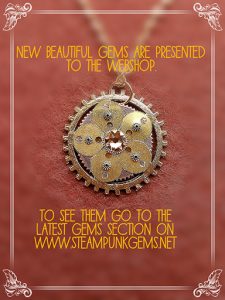 During the starting phase of Gwendolyne’s Steampunk Gems, Gwendolyne still used glass rhinestones in the earliest handmade jewellery products, but soon realised that crystal rhinestones are a much better way of giving that extra sparkle and beauty to her Steampunk jewellery. Since then she has decided to mainly work with Swarovski crystal rhinestones in her Steampunk designs or genuine gemstones, when possible.
During the starting phase of Gwendolyne’s Steampunk Gems, Gwendolyne still used glass rhinestones in the earliest handmade jewellery products, but soon realised that crystal rhinestones are a much better way of giving that extra sparkle and beauty to her Steampunk jewellery. Since then she has decided to mainly work with Swarovski crystal rhinestones in her Steampunk designs or genuine gemstones, when possible.
Gwendolyne Blaney – GSG
References
Wikipedia – https://en.wikipedia.org/Wiki/Rhinestone – “Rhinestone”
Wikipedia – https://en.wikipedia.org/wiki/Rhine – “Rhine”
